name: inverse layout: true class: center, middle, inverse <div class="my-header"><span> <a href="/training-material/topics/metabolomics" title="Return to topic page" ><i class="fa fa-level-up" aria-hidden="true"></i></a> <a href="https://github.com/galaxyproject/training-material/edit/main/topics/metabolomics/tutorials/qcxms-predictions/slides.html"><i class="fa fa-pencil" aria-hidden="true"></i></a> </span></div> <div class="my-footer"><span> <img src="/training-material/assets/images/GTN-60px.png" alt="Galaxy Training Network" style="height: 40px;"/> </span></div> --- <img src="/training-material/assets/images/GTNLogo1000.png" alt="Galaxy Training Network" class="cover-logo"/> <br/> <br/> # Predicting EI+ mass spectra with QCxMS <br/> <br/> <div markdown="0"> <div class="contributors-line"> <ul class="text-list"> <li> <a href="/training-material/hall-of-fame/hechth/" class="contributor-badge contributor-hechth"><img src="/training-material/assets/images/orcid.png" alt="orcid logo" width="36" height="36"/><img src="https://avatars.githubusercontent.com/hechth?s=36" alt="Helge Hecht avatar" width="36" class="avatar" /> Helge Hecht</a> <li> <a href="/training-material/hall-of-fame/wverastegui/" class="contributor-badge contributor-wverastegui"><img src="https://avatars.githubusercontent.com/wverastegui?s=36" alt="Wudmir Rojas avatar" width="36" class="avatar" /> Wudmir Rojas</a> <li> <a href="/training-material/hall-of-fame/zargham-ahmad/" class="contributor-badge contributor-zargham-ahmad"><img src="https://avatars.githubusercontent.com/zargham-ahmad?s=36" alt="Zargham Ahmad avatar" width="36" class="avatar" /> Zargham Ahmad</a> <li> <a href="/training-material/hall-of-fame/wee-snufkin/" class="contributor-badge contributor-wee-snufkin"><img src="/training-material/assets/images/orcid.png" alt="orcid logo" width="36" height="36"/><img src="https://avatars.githubusercontent.com/wee-snufkin?s=36" alt="Julia Jakiela avatar" width="36" class="avatar" /> Julia Jakiela</a></li> </ul> </div> </div> <!-- modified date --> <div class="footnote" style="bottom: 8em;"> <i class="far fa-calendar" aria-hidden="true"></i><span class="visually-hidden">last_modification</span> Updated: <i class="fas fa-fingerprint" aria-hidden="true"></i><span class="visually-hidden">purl</span><abbr title="Persistent URL">PURL</abbr>: <a href="https://gxy.io/GTN:S00125">gxy.io/GTN:S00125</a> </div> <!-- other slide formats (video and plain-text) --> <div class="footnote" style="bottom: 5em;"> <i class="fas fa-file-alt" aria-hidden="true"></i><span class="visually-hidden">text-document</span><a href="slides-plain.html"> Plain-text slides</a> | </div> <!-- usage tips --> <div class="footnote" style="bottom: 2em;"> <strong>Tip: </strong>press <kbd>P</kbd> to view the presenter notes | <i class="fa fa-arrows" aria-hidden="true"></i><span class="visually-hidden">arrow-keys</span> Use arrow keys to move between slides </div> ??? Presenter notes contain extra information which might be useful if you intend to use these slides for teaching. Press `P` again to switch presenter notes off Press `C` to create a new window where the same presentation will be displayed. This window is linked to the main window. Changing slides on one will cause the slide to change on the other. Useful when presenting. --- ## Requirements Before diving into this slide deck, we recommend you to have a look at: - [Introduction to Galaxy Analyses](/training-material/topics/introduction) --- name:qcxms-spectra-predictions ### Motivation .pull-left[ - MS data annotation poses a universal bottleneck in research. - *In silico* spectra prediction using machine learning or quantum chemistry is a promising technique for annotation of unknown compounds. - QCxMS offers reasonably accurate in silico annotation, especially for organic molecules. - The complexity of quantum chemistry predictions presents challenges for non-HPC experts. - Integrating QCxMS into Galaxy provides valuable molecular insights. Our Goal: Make semi-empirical Quantum Chemistry (QC)-based predictions accessible without advanced computational skills. ] .pull-right[ 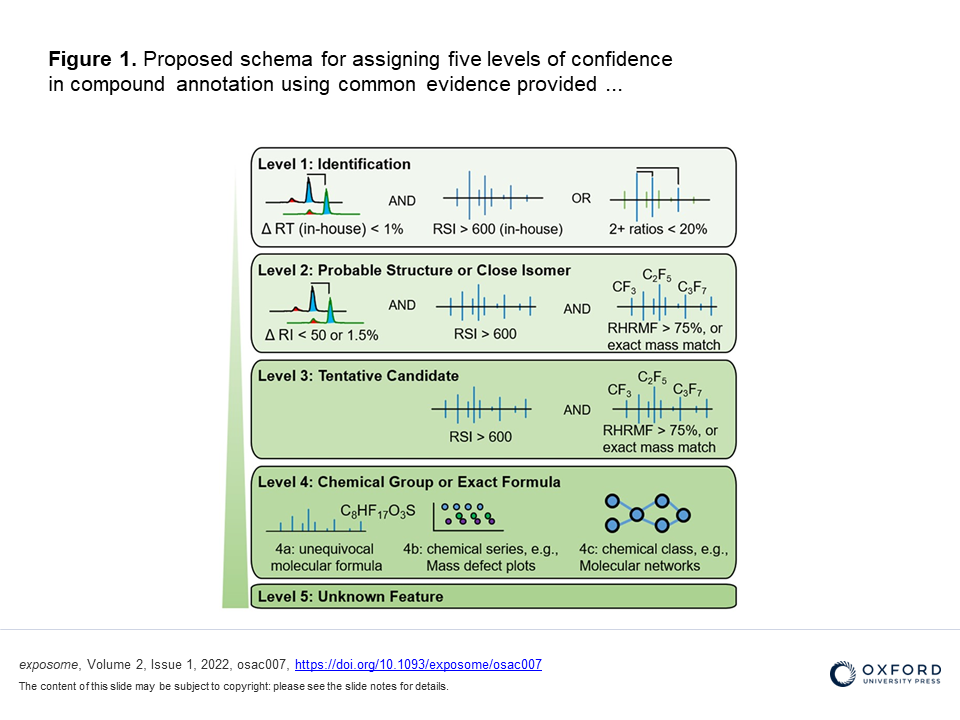 ] --- ### Method 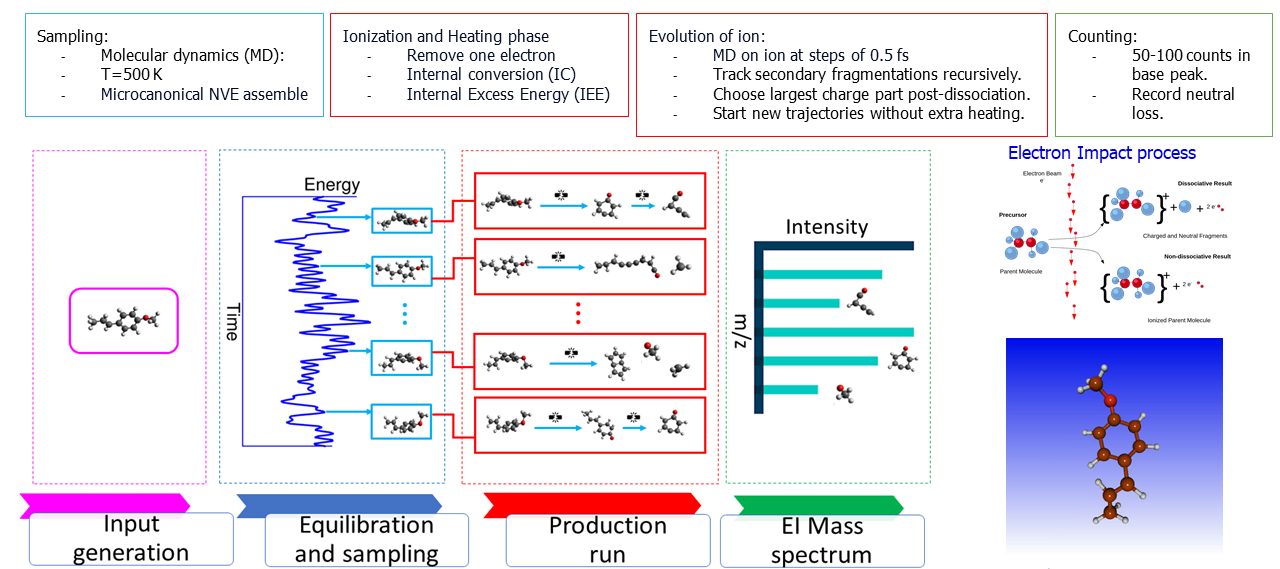 - Calculations can be performed using multiple quantum chemistry frameworks. - This includes full *ab initio* molecular dynamics or parameterized *semi-empirical quantum mechanical* methods. - Semi-empirical methods are significantly faster (hours vs. weeks) while yielding reasonable accuracy. --- ### HPC Workflow  - The HPC-based workflow is configured to work with a PBS job scheduler and is therefore somwhat limited in flexibility and user friendliness. - Due to the difficulties of working with HPC clusters, we ported this workflow to Galaxy. --- ### Galaxy Workflow 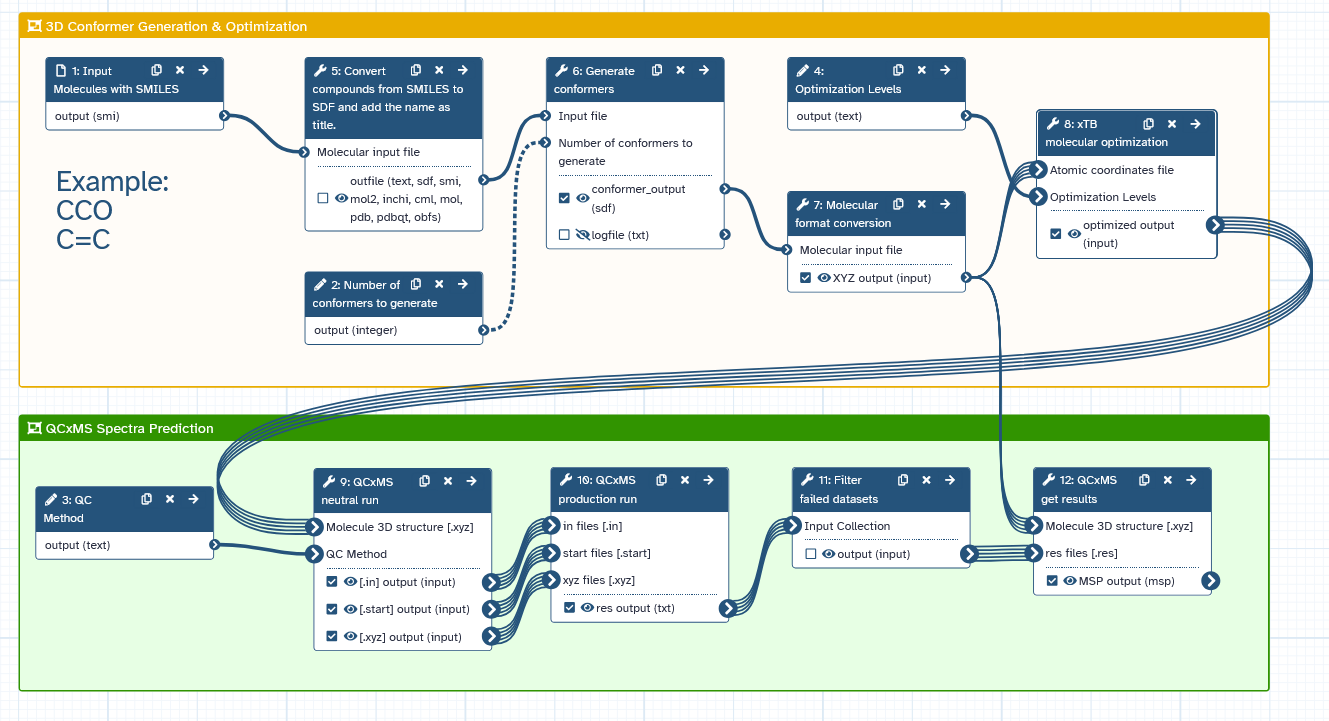 - We use xTB to optimize the input geometry. - The QCxMS neutral run tool performs the equilibration and sampling to create the trajectories. - The QCxMS production run tool performs the simulation of each trajectory. - The QCxMS getres tool collects the results into an MSP file. --- ### Galaxy Tool Structure 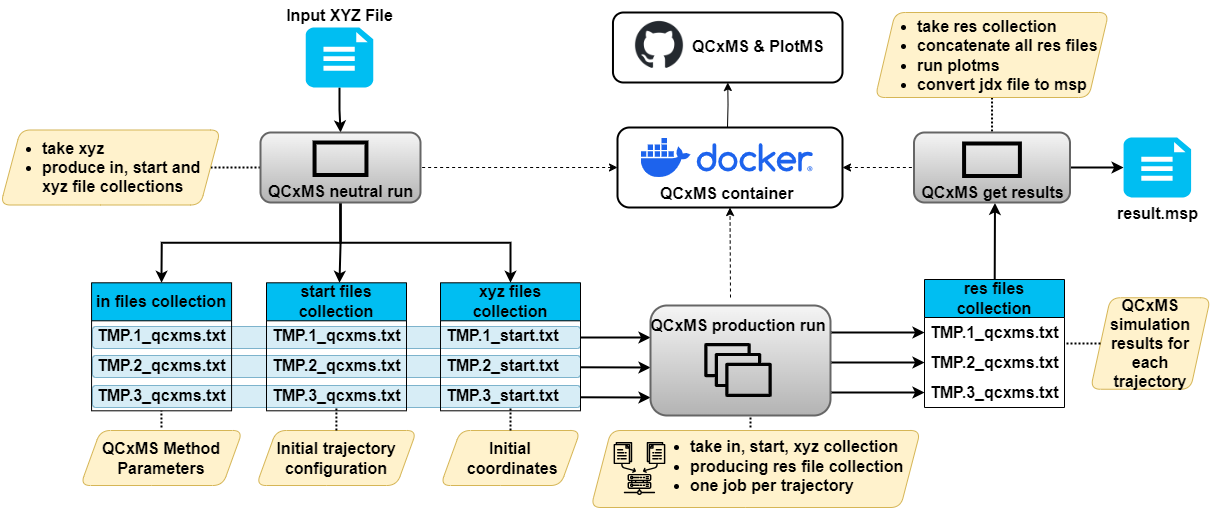 - Each trajectory is computed in a single job, using data-level parallelism. - All QCxMS tools utilize the same docker container with an executable which was compiled with an optimized compiler. --- ### Runtime Performance Metrics 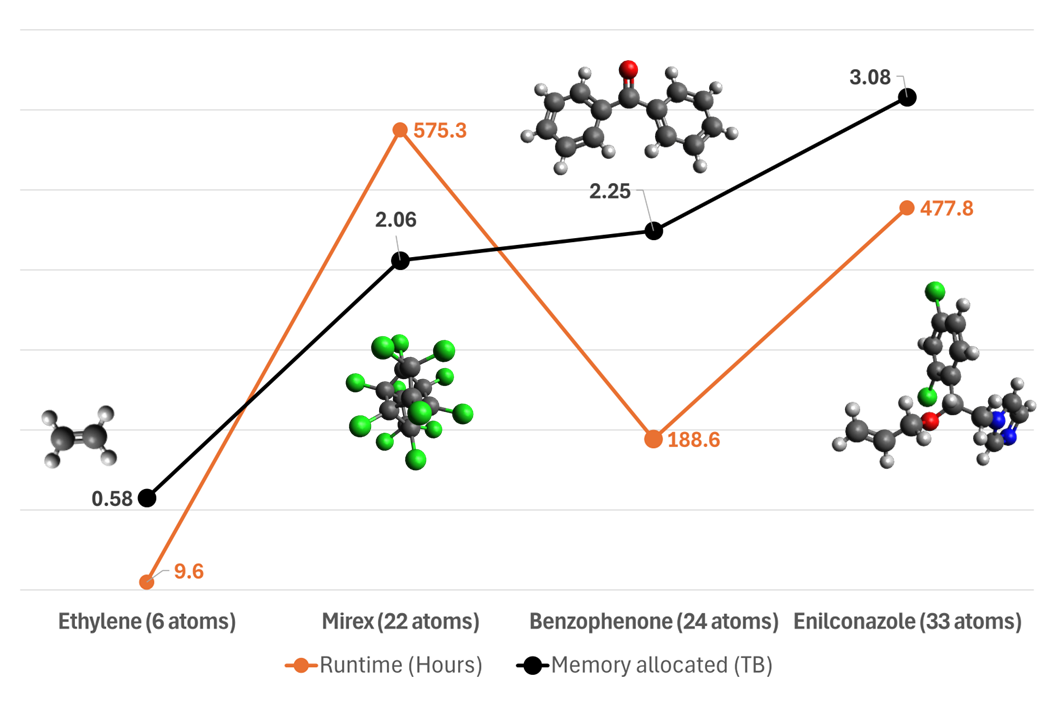 - Runtime depends primarily on size of the molecule. - Structure also plays a crucial role - the more complex the geometry and structure, the longer the computations take. - Memory requirements scale linear with size of the molecule. --- ### References - Grimme, S. (2013). Towards First Principles Calculation of Electron Impact Mass Spectra of Molecules. Angewandte Chemie International Edition, 52(24), 6306–6312. https://doi.org/10.1002/anie.201300158 - Bauer, C. A., & Grimme, S. (2016). How to Compute Electron Ionization Mass Spectra from First Principles. The Journal of Physical Chemistry A, 120(21), 3755–3766. https://doi.org/10.1021/acs.jpca.6b02907 - Bannwarth, C., Ehlert, S., & Grimme, S. (2019). GFN2-xTB—An Accurate and Broadly Parametrized Self-Consistent Tight-Binding Quantum Chemical Method with Multipole Electrostatics and Density-Dependent Dispersion Contributions. Journal of Chemical Theory and Computation, 15(3), 1652–1671. https://doi.org/10.1021/acs.jctc.8b01176 - Koopman, J., & Grimme, S. (2021). From QCEIMS to QCxMS: A Tool to Routinely Calculate CID Mass Spectra Using Molecular Dynamics. Journal of the American Society for Mass Spectrometry, 32(7), 1735–1751. https://doi.org/10.1021/jasms.1c00098 - Hecht, H., Rojas, W. Y., Ahmad, Z., Křenek, A., Klánová, J., & Price, E. J. (2024). Quantum Chemistry-Based Prediction of Electron Ionization Mass Spectra for Environmental Chemicals. Analytical Chemistry, 96(33), 13652–13662. https://doi.org/10.1021/acs.analchem.4c02589 --- ## Thank You! This material is the result of a collaborative work. Thanks to the [Galaxy Training Network](https://training.galaxyproject.org) and all the contributors! <div markdown="0"> <div class="contributors-line"> <table class="contributions"> <tr> <td><abbr title="These people wrote the bulk of the tutorial, they may have done the analysis, built the workflow, and wrote the text themselves.">Author(s)</abbr></td> <td> <a href="/training-material/hall-of-fame/hechth/" class="contributor-badge contributor-hechth"><img src="/training-material/assets/images/orcid.png" alt="orcid logo" width="36" height="36"/><img src="https://avatars.githubusercontent.com/hechth?s=36" alt="Helge Hecht avatar" width="36" class="avatar" /> Helge Hecht</a><a href="/training-material/hall-of-fame/wverastegui/" class="contributor-badge contributor-wverastegui"><img src="https://avatars.githubusercontent.com/wverastegui?s=36" alt="Wudmir Rojas avatar" width="36" class="avatar" /> Wudmir Rojas</a><a href="/training-material/hall-of-fame/zargham-ahmad/" class="contributor-badge contributor-zargham-ahmad"><img src="https://avatars.githubusercontent.com/zargham-ahmad?s=36" alt="Zargham Ahmad avatar" width="36" class="avatar" /> Zargham Ahmad</a><a href="/training-material/hall-of-fame/wee-snufkin/" class="contributor-badge contributor-wee-snufkin"><img src="/training-material/assets/images/orcid.png" alt="orcid logo" width="36" height="36"/><img src="https://avatars.githubusercontent.com/wee-snufkin?s=36" alt="Julia Jakiela avatar" width="36" class="avatar" /> Julia Jakiela</a> </td> </tr> <tr class="reviewers"> <td><abbr title="These people reviewed this material for accuracy and correctness">Reviewers</abbr></td> <td> <a href="/training-material/hall-of-fame/shiltemann/" class="contributor-badge contributor-badge-small contributor-shiltemann"><img src="https://avatars.githubusercontent.com/shiltemann?s=36" alt="Saskia Hiltemann avatar" width="36" class="avatar" /></a><a href="/training-material/hall-of-fame/foellmelanie/" class="contributor-badge contributor-badge-small contributor-foellmelanie"><img src="https://avatars.githubusercontent.com/foellmelanie?s=36" alt="Melanie Föll avatar" width="36" class="avatar" /></a><a href="/training-material/hall-of-fame/wee-snufkin/" class="contributor-badge contributor-badge-small contributor-wee-snufkin"><img src="https://avatars.githubusercontent.com/wee-snufkin?s=36" alt="Julia Jakiela avatar" width="36" class="avatar" /></a></td> </tr> </table> </div> </div> <div style="display: flex;flex-direction: row;align-items: center;justify-content: center;"> <img src="/training-material/assets/images/GTNLogo1000.png" alt="Galaxy Training Network" style="height: 100px;"/> </div> Tutorial Content is licensed under <a rel="license" href="http://creativecommons.org/licenses/by/4.0/">Creative Commons Attribution 4.0 International License</a>.<br/>